4.4 German currency: The Euro
The changeover from the Deutsche Mark
 At the stroke of midnight on 1 January 2002, amidst firework displays across the European mainland, euro notes and coins were introduced into Germany, Austria and 10 other member states of the European Union. The old German currency, die Deutsche Mark (DM) or die D-Mark (but NOT "Deutschmark"!) was still legal tender until 28 February 2002, after which point der Euro (€ or EUR) became the only acceptable currency in Germany. Should you still have any German marks or pfennigs (the smaller denomination of the old currency), it is still possible to exchange them at German banks. Postage stamps issued in D-Marks ceased to be legally valid in June 2002. At the stroke of midnight on 1 January 2002, amidst firework displays across the European mainland, euro notes and coins were introduced into Germany, Austria and 10 other member states of the European Union. The old German currency, die Deutsche Mark (DM) or die D-Mark (but NOT "Deutschmark"!) was still legal tender until 28 February 2002, after which point der Euro (€ or EUR) became the only acceptable currency in Germany. Should you still have any German marks or pfennigs (the smaller denomination of the old currency), it is still possible to exchange them at German banks. Postage stamps issued in D-Marks ceased to be legally valid in June 2002.
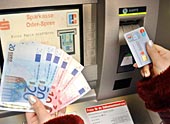 As you can imagine, changing the currency proved to be a huge logistical undertaking which in itself is estimated to have cost 2.4 billion Marks. 28.5 billion coins and 2.6 billion notes from the D-Mark era needed to be taken out of circulation, whilst at the same time 15.5 billion coins and 2.5 billion euro banknotes needed to be introduced to shops, banks and cashpoints (see picture). As you can imagine, changing the currency proved to be a huge logistical undertaking which in itself is estimated to have cost 2.4 billion Marks. 28.5 billion coins and 2.6 billion notes from the D-Mark era needed to be taken out of circulation, whilst at the same time 15.5 billion coins and 2.5 billion euro banknotes needed to be introduced to shops, banks and cashpoints (see picture).
Yet the changeover passed smoothly, not least because Germans had been well prepared for it by a Government information campaign. Furthermore, although the euro notes and coins were only introduced into circulation at the start of 2002, the new currency could be used from 1 January 1999 onwards in the form of "written money" - that is, by means of cheques, travellers' cheques, bank transfers and credit cards. Thus many German employees could choose whether they wished to be paid in euros or marks. Nevertheless, it was calculated in May 2005 that coins to the value of 3.72 thousand million Deutschmarks and notes to the value of 3.94 thousand million Marks were still in circulation. The German Bundesbank believes however that much of this is money that has either been lost or destroyed.
As the pictures below indicate, shops and supermarkets started to list prices in both marks and euros from 1999 onwards:
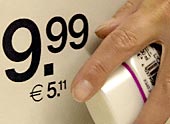 |
 |
 But although the advantages of a single European currency have been widely accepted, many Germans nevertheless bade farewell to the mark with great reluctance. The mark had been a symbol of fifty years of German post-War reliability and economic revival, banishing the traumatic memories of hyper-inflation in the 1920's, when the currency was worth that little that people needed to transport it in wheelbarrows if they needed to buy something substantial. Since the mark became fully convertible in 1958, no other major currency, including the Japanese yen or the Swiss franc, had been stronger. It had become the second-largest currency component of global monetary reserves, second only to the United States dollar - which itself lost about two-thirds of its value against the Deutsche Mark since 1958. But although the advantages of a single European currency have been widely accepted, many Germans nevertheless bade farewell to the mark with great reluctance. The mark had been a symbol of fifty years of German post-War reliability and economic revival, banishing the traumatic memories of hyper-inflation in the 1920's, when the currency was worth that little that people needed to transport it in wheelbarrows if they needed to buy something substantial. Since the mark became fully convertible in 1958, no other major currency, including the Japanese yen or the Swiss franc, had been stronger. It had become the second-largest currency component of global monetary reserves, second only to the United States dollar - which itself lost about two-thirds of its value against the Deutsche Mark since 1958.
 German suspicions about the euro have been increased by popular fears that manufacturers and shopkeepers took advantage of the introduction of the new currency to raise prices on the sly. The price of everyday times staples such as bread and restaurant meals have been particularly affected, with price rises of 100% being registered on some consumer staples. Consumer groups and tabloid newspapers have rechristened the new currency "der Teuro", which is a play on the German word for expensive "teuer". German suspicions about the euro have been increased by popular fears that manufacturers and shopkeepers took advantage of the introduction of the new currency to raise prices on the sly. The price of everyday times staples such as bread and restaurant meals have been particularly affected, with price rises of 100% being registered on some consumer staples. Consumer groups and tabloid newspapers have rechristened the new currency "der Teuro", which is a play on the German word for expensive "teuer".
As the alleged price increases were not reflected in the rate of inflation, the German government was initially slow to react to popular discontent. Having been overcharged for a sandwich in May 2002 however, Finance Minister Hans Eichel called for a consumer boycott of businesses which had tried to cash in on the currency changeover. Consumer affairs minister Renate Künast has also convened a meeting with retail and trade groups to push for "a return to fair prices."
But the overall impression remains that the changeover to the new currency has been much more successful than Euro-sceptics had predicted. In 2006, an opinion poll showed that 46% of Germans agreed with the statement: "The Euro is good for us and makes us stronger for the future". An almost equal number of Germans (44%) thought however that the Euro "weakens the country". Yet by the end of 2007, a survey by the Dresdner Bank found that only 36% of Germans were in favour of the euro, compared to 43% in a similar survey in 2004.
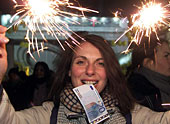 |
| 1. Jan. 2002: The new euro |
|
What's a euro worth?
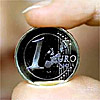 Since January 1 1999, the euro has had an irrevocably fixed conversion rate against the national currencies participating in the Eurozone. From that date onwards, the value of one euro has been fixed at 1.95583 German marks. This has proved useful in helping German citizens to come to terms with the new currency, as one euro is thus roughly equal to two German marks. One euro is also worth: Since January 1 1999, the euro has had an irrevocably fixed conversion rate against the national currencies participating in the Eurozone. From that date onwards, the value of one euro has been fixed at 1.95583 German marks. This has proved useful in helping German citizens to come to terms with the new currency, as one euro is thus roughly equal to two German marks. One euro is also worth:
- 13.7903 Austrian schillings (ATS)
- 40.3399 Belgian francs (BEF)
- 5.94573 Finnish markka (FIM)
- 6.55957 French francs (FRF)
- 340.750 Greek drachma (GRD)
- 0.787564 Irish pounds (IEP)
- 1936.27 Italian lira (ITL)
- 40.3399 Luxembourg francs (LUF)
- 2.20371 Dutch guilders (NLG)
- 200.482 Portuguese escudos (PTE)
- 166.386 Spanish pesetas (ESP)
 You can use the converter below to see what the euro is worth in a range of European currencies. Click a country button to display currency name and full fixed euro exchange rate (DEM = German mark). Press Clear to empty the value boxes and enter either Euro or Local amount to convert. Click the appropriate button for conversion of "Euro" to "local amount" or of "local amount" to "Euro". Conversion will display selected currency exchange rounded to two decimal places. You can use the converter below to see what the euro is worth in a range of European currencies. Click a country button to display currency name and full fixed euro exchange rate (DEM = German mark). Press Clear to empty the value boxes and enter either Euro or Local amount to convert. Click the appropriate button for conversion of "Euro" to "local amount" or of "local amount" to "Euro". Conversion will display selected currency exchange rounded to two decimal places.
There are of course no fixed exchange rates for currencies of countries which are not in the Eurozone. In June 2002, one euro was worth 0.643 British pounds (and one British pound was thus worth 1.555 euros). One euro was also worth 0.945 United States dollars.
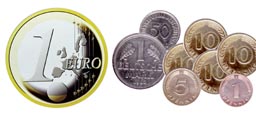
 |
Web Links |
 |
 Web sites on the euro currency Web sites on the euro currency |
 |
The Universal Currency Converter |
Convert your own currency in and out of euros with this online currency converter. |
 |
Euro Currency Converter |
Download a currency converter for your PC which enables you to convert prices into euros from the 12 currencies taking part in the euro. And vice versa! |
 |
European Central Bank |
The English language web pages of the European Central Bank tell you everything you need to know about the new currency and which countries have now signed up to it. |
 |
Euro coins and notes |
Learn more about the euro notes and coins and how different they appear in different countries. |
 |
Changing DM into euros |
The English language pages of the Deutsche Bundesbank explain how to go about changing any remaining German Marks into euros. |
 |
The Guardian |
A dossier of articles from The Guardian on the introduction of the euro across Europe. |
 |
Euro or "Teuro"? The Euro-induced perceived inflation in Germany |
Hans Wolfgang Brachinger's article, published in 2006, concludes that a special inflation may indeed have taken place in Germany around the time of the introduction of the Euro notes and coins. |
 |
Der Euro als Teuro? |
Did the change from Deutschmark to euro really produce inflation in Germany? This 2005 article is in German only. |
|
 Chapter 4.5: Euro notes and coins Chapter 4.5: Euro notes and coins
 Nach oben Nach oben
 Print This Page Print This Page
|